 Fact Sheet: The RSAF Leverages Technology for Enhanced Foundational Training amidst COVID-19
Fact Sheet: The RSAF Leverages Technology for Enhanced Foundational Training amidst COVID-19
Background
The Republic of Singapore Air Force (RSAF) Air Force Training Command (AFTC)'s mission is to develop air force leaders and professionals committed to the mission of the RSAF and steeped in core values with strong foundational competencies. As the centre of foundational training for all RSAF vocations, AFTC plays a key role in strengthening the RSAF's operational capabilities by ensuring personnel receive training that is operationally relevant and realistic. To this end, AFTC has incorporated cutting-edge technologies to enhance training realism and effectiveness, overcome training constraints and upkeep training tempo amidst COVID-19.
Advanced Simulator Systems
Air Traffic Control (ATC) Simulator. The ATC Simulator comprises a radar simulator and 360o Tower for training of Air Warfare Officers (AWO) (ATC). The radar simulator provides realistic training in air traffic control and air defence functions such as airspace management and intercept control. The 360o Tower simulates various environments for realistic training in runway management and control of airborne aircraft within the aerodrome terminal area. It is also able to simulate various situations and contingencies within a virtual and controlled environment to better prepare AWO (ATC) trainees for different situations they would face in their operational roles. The man-machine interface of the ATC Simulator also closely mimics operational systems, so that AWO (ATC) trainees can transit to their operational units with higher levels of proficiency. Together, the ATC simulator can be configured to provide integrated training between the radar and 360o Tower simulator. This enables AWO (ATC) trainees to be able to practise the full spectrum of ATC operations required for a mission from airbase launch, transit through controlled airspace to operational areas, mission execution and recovery to airbase.
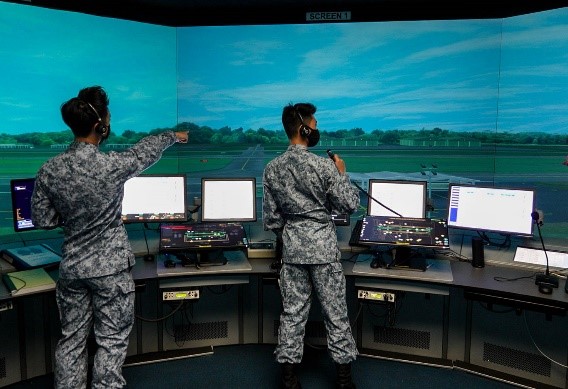
AWO (ATC) trainees in the 360o Tower of the ATC Simulator.
Enhanced Pilot Trainee Training and Assessment System. The RSAF is exploring the use of advanced high-fidelity simulators, paired with biometric sensors, to enhance pilot training and assessment. The system collects non-invasive psychophysiological measurements, such as eye movement, heart rate and facial expressions whilst the trainee is in the simulator, to gain insights into a trainee's performance. Through data analytics and artificial intelligence, the RSAF can analyse the reactions of each pilot trainee, and help them to improve their flying performance in different training scenarios.
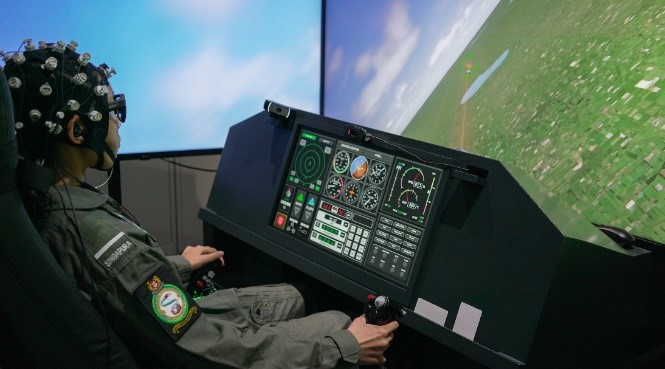
A pilot trainee going through the Enhanced Pilot Trainee Training and Assessment System.
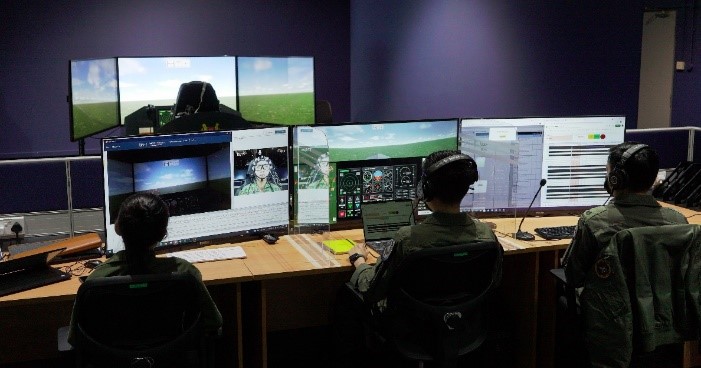
Monitoring psychophysiological measurements of a pilot trainee.
Immersive Learning Technologies to Enhance Training
Virtual Safety Behaviour Training (VSBT). VSBT is a learning tool to instil safety consciousness in Air Force Engineer (AFE) trainees by exposing them to the consequences of unsafe situations or unsafe acts during routine maintenance via the use of Virtual Reality (VR). The VSBT learning tool builds upon the theoretical lessons AFE trainees receive by immersing them in VR scenarios that replicate actual maintenance activities in operational environments. With accurate spatial, visual and audio stimulus, trainees practise their safety consciousness whilst performing routine maintenance tasks, and in the case of non-adherence to safety practices, will experience the consequences of unsafe situations and behaviours in the simulated VR environment. The VSBT learning tool reinforces the safety consciousness of AFE trainees and trains them in their safety habits and responses.
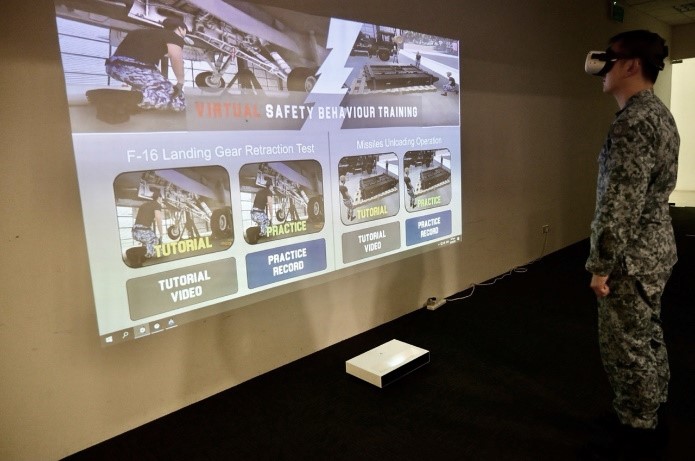
An AFE trainee practising safety consciousness whilst performing a maintenance task using the VSBT.
Virtual Reality Dynamic Aircraft Recognition Trainer System (VR-DARTS). VR-DARTS is a training tool that uses VR to enhance the realism of aircraft recognition training, increase trainee engagement, and enables instructors to provide targeted and immediate feedback. VR-DARTS simulates flight profiles similar to actual operations which allow Ground Base Air Defence (GBAD) trainees to observe various aerial platforms under realistic conditions without the need to have actual flying platforms. VR-DARTS is able to simulate varying environmental conditions and aircraft flight profiles including distance and flight angles of the aircraft. VR-DARTS also has assessment modules, which when coupled with observations of the trainee's physical head movements, enables trainers to provide immediate and targeted feedback. Through VR-DARTs, GBAD trainees are exposed to wide-ranging operational scenarios, enabling them to transit effectively from training to operations.
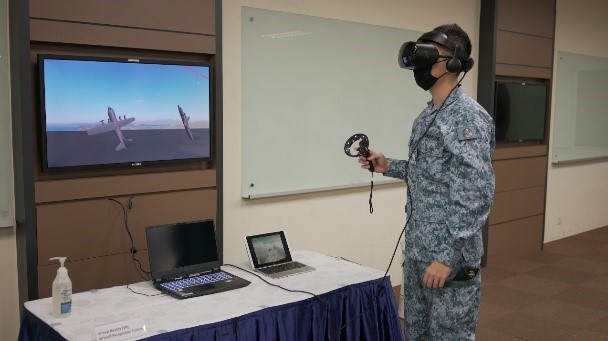
A GBAD trainee using the VR-DARTS to view aircraft models.
Virtual Reality Escape Room. VR Escape Room, developed in-house by Air Engineering Training Institute, is a learning tool that leverages gamification to enhance content delivery and engagement of AFE trainees. The VR Escape Room tool simulates aircraft maintenance tasks and associated safety considerations and problems in a multiplayer game setting. It allows collaborative learning, and exposes AFE trainees to the value of effective teamwork and clear communications during aircraft maintenance tasks.
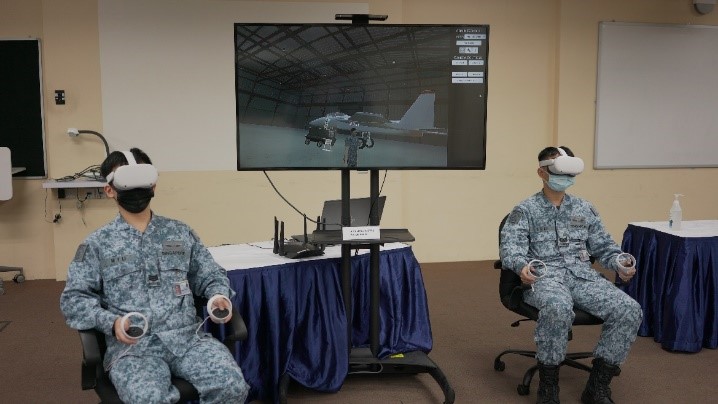
AFE trainees going through the escape room simulation together.
Augmented Reality (AR) Voice-Activated Head Mounted Tablet (HMT). The HMT is a tool to train AFE trainees in aircraft maintenance tasks. The AR and voice-activated functions allow the trainees to retrieve and refer to information on their tasks, instead of having to refer to hardcopy manuals. The HMT also has a Remote Mentoring feature, which allows the HMT to transmit what the trainees are seeing to a separate display. Instructors and other trainees can remotely observe the trainee's actions without visual obstruction, which is especially useful for maintenance tasks in tight spaces, and trainees can also receive immediate coaching or instruction.
The HMT also has step-by-step instructional videos that allow trainees to practice their maintenance skills during self-directed learning or for refresher purposes. This makes training of routine tasks more efficient, and enables instructors to tailor their training methods accordingly.
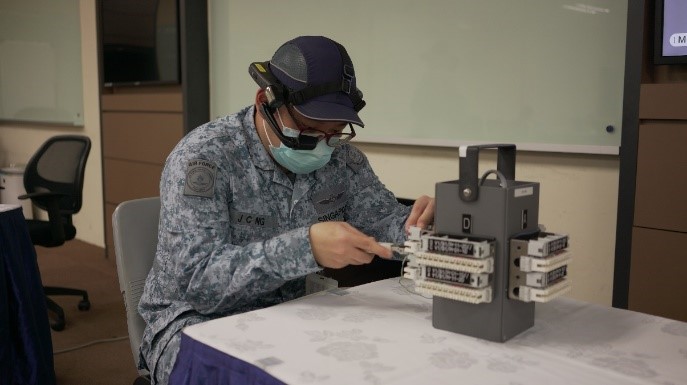
An AFE trainee using the HMT to carry out a training maintenance task.
